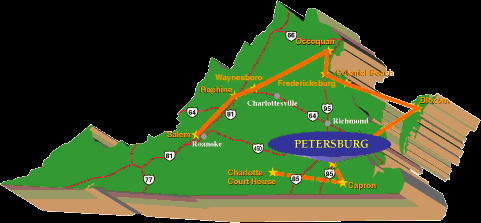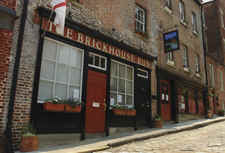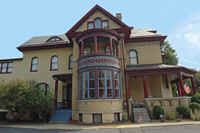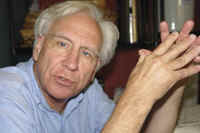
Download
in PDF Format
With nearly three centuries of
Americana and a now-
burgeoning Old Towne commercial
district, visitors have numerous choices to satisfy their historical
curiosity and enhance their enjoyment of Petersburg, a Southside Virginia
community located about 25 miles south of Richmond on Interstate 95.
|

The
Brickhouse Run, an English pub, is located in the heart of Olde
Town Petersburg. |
The Cockade City, named by President
James Madison for the emblems worn by the Petersburg Volunteers on their
hats in the War of 1812, is a destination for all who want to explore the
rich heritage of a community involved in the Revolutionary War, the War of
1812 and the Civil War.
What enabled this region to prosper in
the past is still evident today among the diverse membership of the
business community, which has contributed to the revitalization of a city
striving to attain its former status.
In the 19th century, Petersburg was
the showcase of the South, replete with tobacco trade, iron works, cotton
mills and flour mills -� and a port second to none. It also contained
the largest free black community, which made up one-third of the
population.
|

The
High Street Inn, a B&B in the historic district, exudes
Victorian charm and is a short walk from many of the city's
attractions. |
The Siege of Petersburg, which lasted
10 long months, changed the social as well as the visual landscape
forever. Union Forces relentlessly bombarded the city, resulting in the
loss of lives, residences, businesses and the capacity to cultivate
sustenance.
Finally, after the Battle of the
Crater, where both sides experienced devastating losses when a failed
Union plan to tunnel beneath and dynamite Confederate troops backfired,
Confederate Gen. Robert E. Lee acquiesced the four-year struggle, and
surrendered to Union Gen. Ulysses S. Grant at nearby Appomattox Court
House.
Just as spirited citizens were roused
to rebuild after the war and a devastating 1815 fire in the Old Towne
section, Petersburg has again begun to experience resurgence in its growth
through the renovation of historic buildings as residences and businesses.
|

Jim
Hiller, who has restored a number of homes in Petersburg,
appreciates the hospitality of its residents. |
One of the early pioneers in recent
years is James Hillier, a Chesterfield County native, who related that as
a child he and his father would come to Petersburg�s High Street area.
He was initially amazed that there were �so many different styles (of
architecture) within a few feet.�
Later he would visit as an adult with
his childhood memories of the city intact. For 15 years he visited often,
looking back in his rear-view mirror as he left to return to his Richmond
residence, saying, �I�ll never live in Petersburg.�
He had restored some homes in
Richmond, would still visit the Cockade City, then closed his restaurant,
and decided it was time to retract his reticence.
Hillier bought a house on Market
Street, renovated it, sold it, then bought the High Street Inn, made
renovations and re-opened it as a bed and breakfast. He sold that venture,
leaving to buy other historic homes and then reselling them, too.
What made him a believer in the city
has been the hospitality of its residents and business community. �When
I got here, I was almost immediately welcomed. The second time in the
bank, they remembered my name,� he recalls.
That warm welcome continued with an
invitation to join the Architectural Review Board and the Historic
Petersburg Foundation. �I was totally involved with community,� he
says, and compelled to continue efforts to restore and renovate old
buildings.
Today, after 20 years in the
renovation process, Hillier is again occupied with the restoration of a
residence at 42 Perry Street in one of the city�s historic districts.
Before Jamestown colonists settled
here, the Appamattuck Indian tribe, part of the Powhatan federation,
inhabited the area, which was named for fur trader Peter Jones, a friend
of William Byrd II.
In 1645, Jamestown colonists, led by
Capt. Abraham Wood, built a garrison, Fort Henry, and began trade with the
Indians while exploring other regions for settlement.
In 1646, Fort Henry became free from
taxation by the British-occupied Jamestown, the first permanent English
colony in North America, and flourished.
Early settlers located in the area
because of its proximity to a fall line, which provided access to fertile
hunting and fishing grounds and the then-named Appamattuck River for trade
and exploration.
|

Local
historian Delaney Ward is always willing to explain the many
facets of the city's rich history. |
�There are very few places on either
coast that have such a location. Petersburg is important because it is
located between two watersheds,� says local historian Delaney Ward, a
consultant for the city of Petersburg.
With the close proximity of the river,
trade and exploration became pivotal in sustaining a community and
ensuring its longevity. �Petersburg became a major port,� adds Ward.
�Important exporters in Petersburg were known in Europe and Liverpool,
England,� he notes.
As technology developed, so did
Petersburg�s port and railroad system. Dredging of the Appomattox River
allowed large ships to export the bounties of tobacco, cotton, peanuts and
iron to ports around the world. And with access to five rail paths, the
city was a major player in expediting goods and services.
The city and its residents prospered
and Petersburg became known for its wealth of opportunity. Blacks came
from Liberia and created a free black population.
|

Kim
Calos represents one
of Petersburg's "new blood" shop owners. She established
Kimberly Ann's, an eclectic antique boutique.
|
A wealth of potential still sustains
those seeking business opportunities in Petersburg. Kim Calos is one of
those business owners who appreciates the business climate. �It�s one
of the first places that I�ve lived in where people are so
supportive,� she explains.
Why? �It�s because they (business
owners) all have something at stake. Everybody is a stakeholder. If your
neighbor fails, you fail. If they succeed, you do, too,� says Calos,
owner of Kimberly Ann�s, an eclectic antique store on Sycamore Street in
the city�s historic Old Towne district.
The plucky antiques dealer further
explains the good nature of the business community as, �Everybody is
just so nice. It�s unbelievable. If there�s a need, they just jump in
and help. And if you do a favor, it�s returned tenfold.�
Steve and Ella Dickinson, owners of a
British pub, The Brickhouse Run, provide an explanation for the recent
success of business owners in Petersburg. �They (newcomers) are
restoring old buildings as single projects, where a building is restored
as a residence or business: a specific building for a specific purpose.
New owners are concentrating on doing one project and doing it well,�
Ella Dickinson offers.
Such single-mindedness has produced an
array of new art centers and eateries: The Petersburg Regional Art Center,
expansion of the existing Petersburg Area Art League, the creation of The
Friend House Art Gallery, Wabi-Sabi, Andrade�s International Restaurant,
M&M Ice Cream Parlor and The Bistro at Market & Grove.
|

Caroline
Price shops for a bracelet with the help of Wendy Livingston at
the Oak Antique Mall. |
Having a palette of various offerings
is important to Petersburg being viewed as an attraction for locals and
travelers, Ella Dickinson concludes. �Old Towne is now a destination.
People now say, �Hey let�s just go to Old Towne and hang out.� Now,
there are alternatives.�
There are, indeed, many alternatives
for those seeking to discover this lovely city, graced by tree-lined
streets, new signs designating the historic district and the increased
verve of its residents and successful business owners.
An enthusiastic city resident is also
its mayor, Annie Mickens. �It appears that we have now reached a time
when many things are coming together. It�s the right time in
Petersburg,� she says.
Her optimism stems from the inroads
made by the Petersburg Housing and Economic Development Department in
designating mixed-use housing, the upcoming increase of Fort Lee
personnel, the rebuilding of Southside Regional Medical Center, interest
in adding a link to John Tyler Community College in the inner city, the
designation of Petersburg as a link in the Intermodal Center, which will
permit high-speed transit from New York to Atlanta and federal funding and
resources for the Appomattox River dredging project.
The city of Petersburg holds a
fascination for some because of its illustrious past, for others because
of what it can become, and for others still who view it as a renewable
resource to be preserved, protected and loved.